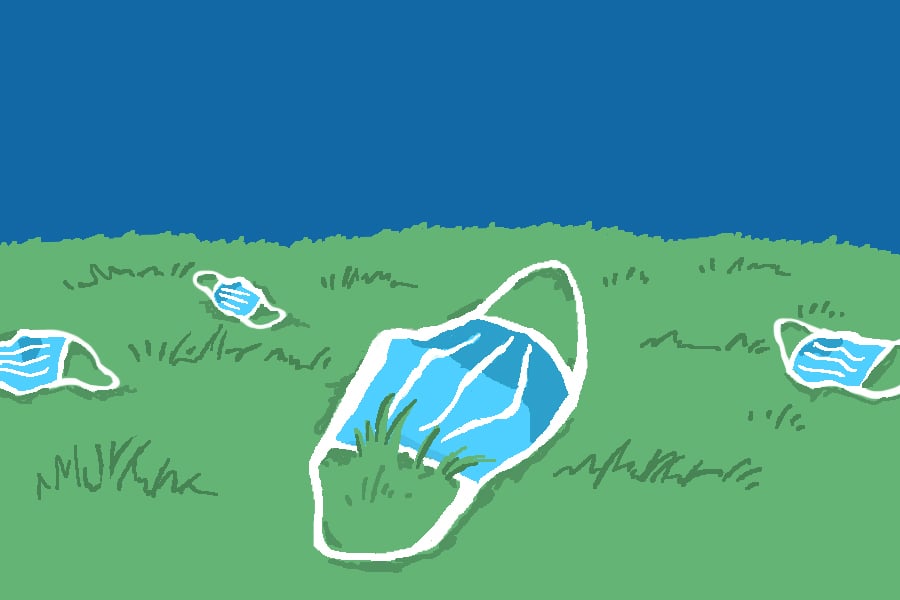Pandemic plastic: How PPE litter is harming Evanston
The pandemic has worsened littering in Evanston due to discarded personal protective equipment.
October 21, 2020
The coronavirus pandemic is generating mountains of medical waste that experts say are overwhelming recycling and garbage centers both in Evanston and across the nation.
In 2018, medical waste company Stericycle handled 1.8 billion pounds of regulated substances globally. While it’s too early to know the full scope of the numbers, Tim Hoellein, an aquatic ecologist at Loyola University Chicago, said the pandemic is likely to exacerbate medical waste pollution. In some localities, such as East Lansing, Michigan, recycling centers have temporarily ceased operations.
Personal protective equipment (PPE) waste not only comes from hospitals but also from residents who do not properly dispose of their masks, gloves or face shields, and some Evanston residents say masks and gloves are strewn across street corners and gutters.
“It’s disheartening,” resident Jill Harvey said. “You see the masks right next to the trash cans. It’s just five extra steps to throw them away.”
According to the Centers for Disease Control and Prevention’s guidelines, hospital medical waste exposed to COVID-19 is treated the same way as other medical waste. 90 percent of this waste is sterilized and sent to landfills, where it continues to emit toxic chemicals into the environment.
The plastic in the landfills, which includes hospital and civic waste, then breaks down into microplastics, which have infiltrated the Milwaukee River and Illinois aquifers, Hoellein said. The other ten percent is incinerated and releases noxious fumes such as dioxin.
Experts say plastic pollution from hospitals is inevitable — littering is a greater problem.
Hoellein conducts litter cleanups with the environmental nonprofit organization Friends of the Chicago River. The cleanup teams, which record the different types of garbage they encounter, had to add a new category for PPE this summer.
Though he could not provide exact data for how much PPE has been collected, Hoellein said the amount is substantial. Additionally, the pandemic has lowered the number of team members who can participate in cleanups, slowing much of his group’s work — which has caused even more litter to accumulate on the beaches.
Hoellein is concerned about increasing PPE waste, but said he remains unsure of its long-term consequences.
“Ultimately, we’re in a situation where it’s like a period of discovery, you know, this field of science,” he said. “Being able to measure these different kinds of materials in the environment is relatively young. This kind of work has been going only on for ten years. I don’t know that (PPE) would be any different than the concentration that’s already out there in much greater numbers.”
James Jennings, a senior public service administrator at the Illinois Environmental Protection Agency, said PPE waste has been one of the group’s primary concerns during the pandemic.
The agency is collaborating with waste haulers and local governments to better understand the PPE “landscape,” as well as its impacts on the waste and recycling stream, he said.
Disposable masks are not recoverable through conventional recycling mechanisms, and improper disposal worsens PPE’s load on plastic pollution, Jennings said. When masks are recycled, they contaminate the entire bale of recyclable materials.
Also, Jennings said because masks are pliable, they can easily hurt or slow sorting machines used to separate items in single-stream recycling. After a PPE-induced clog, recycling facilities must cease operations and completely clear their machines, impairing the broader recycling infrastructure.
According to Jennings, the best way to dispose of masks and gloves is by throwing them away in bags and then into the garbage.
“Masks are conducive to being blown off of recycling bins or trash,” Jennings said. “So throwing it away in a bag first can mitigate littering.”
Kumar Jensen, Evanston’s chief sustainability and resilience officer, said he intends to reduce PPE litter by posting information on the city’s website.
He said the website campaign will launch “in response to citizen complaints,” and concerns about the waste, although the city hasn’t yet finalized its PPE litter data.
Although proper disposal can reduce littering, PPE’s environmental risks remain. Ultimately, it still travels to landfills where it breaks down into microplastics that can infiltrate drinking water and harm aquatic life. A 2018 study by Hoellein and his colleagues found microplastics in the digestive tracts of 85 percent of a sample of fish in three Lake Michigan rivers including the Milwaukee River.
Despite the risks of plastic pollution, Hoellein said he thinks the environmental impact of PPE is not the only thing people should consider.
“We can encourage people to wear cloth masks or whatever other masks when they can,” he said. “But if people need these to be safe, then, you know, I don’t think we should rank the littering as more important than their safety.”
Email: [email protected]
Twitter: @ejun_kim
Related Stories:
— Evanston Environment Board discusses specific implementation of CARP
— Despite speculation, Northwestern climate scientists say COVID-19 is not slowing climate change


